The Pre-War Period
It is probably not known to many that the teaching of physics at university level in Singapore began before Raffles College was established. Physics was a compulsory subject for the medical students in King Edward VII College of Medicine and it was taught by the Government Chemist and other offices of the Government Medical Service. In 1927, Dr E Madgwick was appointed Reader in Physics at King Edward VII College and later Professor of Physics at Raffles College.
The first science students of Raffles College were enrolled in 1928, and in 1929 the Manasseh Meyer Science Building at Bukit Timah campus was opened, half of it being made available to the Department of Physics. Professor Madgwick ran a one-man show for about three years until 1931 when Mr C G Webb joined the department as Demonstrator in Physics. In August 1935, Professor Madgwick resigned and the work of the department was carried on by Mr Webb with the assistance of two demonstrators. Dr N S Alexander from New Zealand arrived in Singapore in late 1936 to occupy the Chair in Physics. Together with Mr Webb and Mr Hon Yung Sen, a local graduate who was appointed as Demonstrator in Physics in 1937, they were the only teaching staff of the Department of Physics until the Japanese invasion in 1941.
In those days, the department provided a three-year course for the college diploma, covering mechanics, heat, light, sound, electricity and magnetism. The courses given in each year consisted of lectures and a series of laboratory experiments. In addition, there was a course for medical and dental students, which was similar to but simpler than the first-year course for the science students. The number of medical and dental students taking physics was usually much larger than that of science students. In the academic year 1935/36, for example, 44 medical and dental students read physics while only 11 science students took first-year physics, five took second-year physics and two took final-year physics.
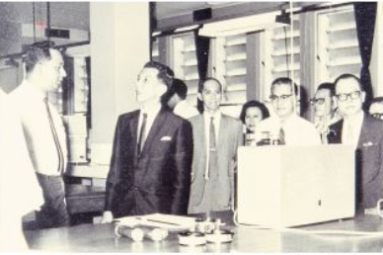
Dr Benjamin Shears, second President of Singapore
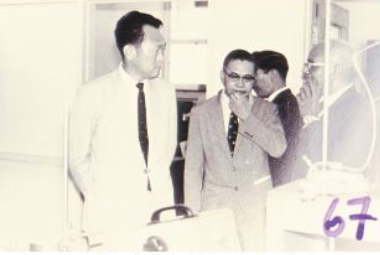
Mr Lee Kuan Yew, first Prime Minister of Singapore
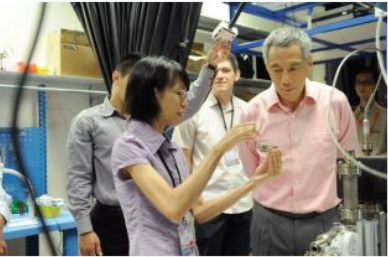
Mr Lee Hsien Loong, current Prime Minister of Singapore
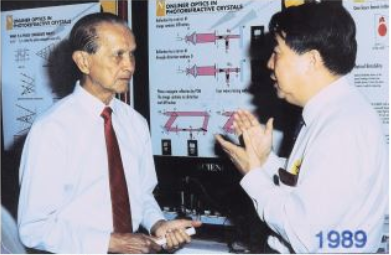
Dr Wee Kim Wee, fourth President of Singapore
The Years Immediately After the War
The physics laboratories, almost empty and without services, were reopened in October 1946. At that time Professor Alexander was away from Singapore and Mr Webb took charge of the restoration of the laboratories and attempted to secure delivery of books and apparatus from the UK. After a year of improvisation, the Department of Physics was back in working order, though on a minimal basis.
Professor Alexander returned in December 1947, but Mr Webb went on leave in early 1948. Mr Hon was away on study leave in the UK. The department was short of staff and this slowed down to a considerable extent the work of rehabilitation, of which a good deal remained to be done at that time. During that year a number of third-year students gave valuable assistance as part-time demonstrators in the practical classes for first-year medical and dental students.
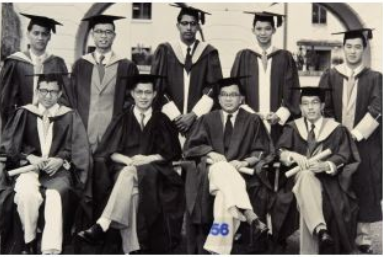
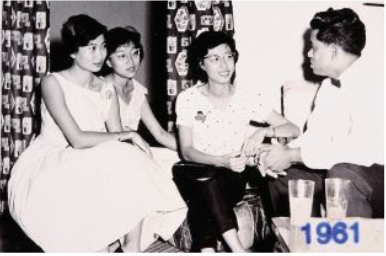
The Early Years of the University of Malaya
In the seven-year span between 1949 and 1956 after the University of Malaya was formed from the amalgamation of Raffles College and King Edward VII College of Medicine, as many as 12 teaching staff were recruited. However, all except two of them stayed for only one or two terms of contract. During this period, both Professor Alexander and Mr Webb had resigned, the former in 1951 and the latter in 1956. Mr Hon Yung Sen became the Acting Head. He took charge of the department for three years until 1959 when Dr K M Gatha arrived to assume the headship.
Since the end of the war up to 1956, the Department of Physics occupied a section of the Manasseh Meyer Block and a temporary hut built by the Japanese during the war. Space was very limited and this placed a constraint on student intake. The problem was not solved until late 1957 when a new physics building was completed. The total number of students attending physics courses each year fluctuated around 85 throughout these years. More than half of these students were medical, dental and engineering students. The honours course was introduced in 1949. The department produced about 15 to 20 pass-degree physics graduates and 2 to 5 honours-degree graduates each year. Many new physics subjects were introduced, but mainly for the honours students. Among them were quantum mechanics, nuclear physics, X-ray crystallography, relativity, electrodynamics and ionosphere physics.
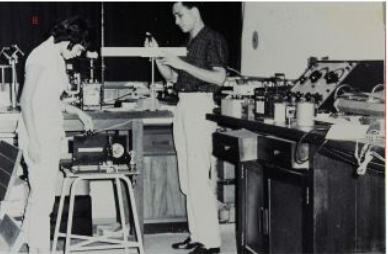
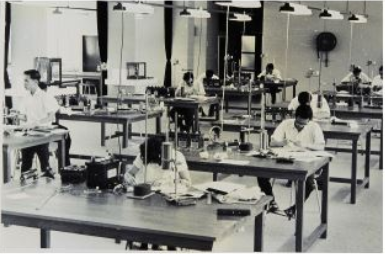
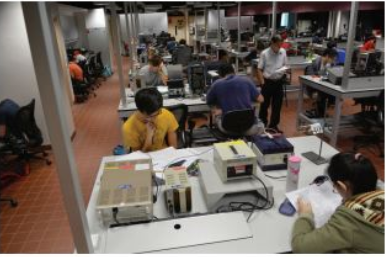
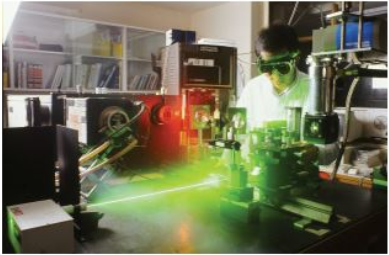
The Sixties to the Eighties in the University of Singapore
In 1960, the governments of the then Federation of Malaya and Singapore indicated their desire to change the status of the divisions into that of a national university. Legislation was passed in 1961 establishing the former Kuala Lumpur division as the University of Malaya while the Singapore division was renamed the University of Singapore on 1 January 1962.
From 1959 to the mid-sixties, the teaching staff number in the Department of Physics increased slowly from 7 to 10. It further went up to 16 in 1973 as many returned scholars joined the department. This number remained about the same for the rest of the decade. Professor Gatha passed away in 1967 and Mr Hon again acted as head of the department until 1969 when Professor A Rajaratnam was appointed as the new head.
The number of pass-degree physics graduates increased steadily from 20 in 1959 to a peak of 79 in 1967. After this peak, it dropped to a low of 22 in 1973 and varied between 30 and 40 for the next few years. The number of honours-degree graduates also followed the same trend, rising from 3 in 1959 to 31 in 1968 and then declined to 13 in 1974. The drop in the physics student enrolment after 1968 was due to the establishment of the Engineering Faculty and the fact that very few students from Malaysia gained entry to the university.
The physics course content and structure had changed a great deal in these twenty years. In 1964, an additional course was introduced for third-year students and henceforth, there were two physics courses—Theoretical Physics and Experimental Physics. Students intending to read honours in physics had to take both courses in their third year. In 1973, the courses were revised and re-structured and the syllabi expanded in all years. Theoretical Physics and Experimental Physics were renamed Physics and Applied Physics respectively. The revision of the physics courses was done to provide students with training relevant to the local industries. Subjects such as workshop technology, linear programming, computer programming, applied electronics and materials science were included in the Applied Physics course.
In 1966, the extension to the physics building in the Bukit Timah campus was completed. The building was formally declared open by the late former Prime Minister Mr Lee Kuan Yew on 1 July 1966.
In the area of research, the activities were generally low in the sixties and seventies. Emphasis was placed on teaching and producing graduates who were in demand by the local industries.
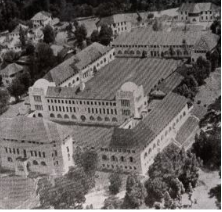
Raffles College, 1949
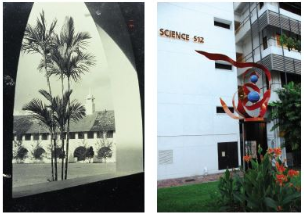
(From left) Bukit Timah Campus, Waves and Particles sculpture at the entrance to the current Department of Physics
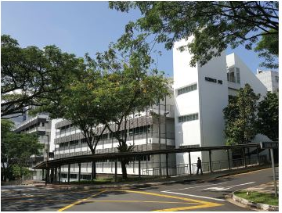
Current view of Blk S12 of the Department of Physics, NUS
The Merger to Form the National University of Singapore
The number of physics academic staff members increased from 15 to 23 with the formation of the Joint Campus and the subsequent merger of the University of Singapore and Nanyang University in 1980 to form the National University of Singapore. Thereafter, it further rose to 29 before the end of 1983. In 1982, Professor Lim Yung Kuo was appointed to head the department. His term of office lasted six years until he retired on 31 October 1988.
Together with the other departments of the Science Faculty, the Department of Physics moved to the Kent Ridge campus in June 1981 before the buildings were fully completed. The laboratories became operational in August 1981 and all equipment purchased under the IBRD loan were installed within the next few months.
The physics student number doubled immediately after the merger but declined slightly in the next few years. The main reason for this was that the Department of Information Systems and Computer Science had increased their student intake during this time. Over the past few years, the Department of Physics had about 250 first-year students, 120 second-year students, 90 third-year students, 30 honours students and 20 higher degree students. Starting from 1988, the department took over the running of the Computer Programming and Applications course from the Department of Information Systems and Computer Science. The number of students taking this course was approaching 700 that year.
A new subject called General Physics was introduced in 1988. This was intended as an optional course for first-year science students who do not plan to major in physics and for second-year students who have not read physics in their first year. Also the physics courses were re-structured and revised again before the 1989/1990 session began. The new course structure enabled the students to concentrate on fewer topics at a time and allowed them greater flexibility in their choice of elective courses.
The research facilities in the department had improved tremendously in the next eight years. This was largely due to the implementation of a new university policy at the beginning of the decade, which gave paramount importance to research. Research grants were generously awarded to academic staff and research scholarships were readily available to students with good honours degree for further studies. Consequently, the number of research publications by staff members also have increased greatly in recent years. Now the department publishes over 50 papers in local and international journals each year.
By 1989, the department had grown from a one-man operation to a full-fledged department with 34 academic staff and 50 technical and office staff. Since its establishment in 1928 until 1989, the department had produced about 1600 pass-degree physics graduates and over 500 graduates with honours and higher degrees. The Diamond Jubilee in 1989 marked the end of the first 60 years and also the beginning of the era of increased support for research and development (R&D) in Singapore.
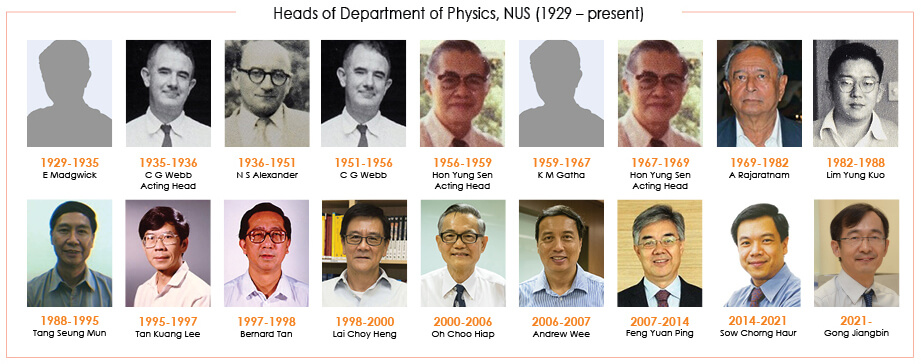
Heads of Department of Physics, NUS (1929 - present)
The Nineties and Beyond
Heads of Department of Physics, MUS (1929 – present)The National Science and Technology Board (NSTB) launched the first national technology plan (NTP) in September 1991. Focusing on economically driven R&D, the government allocated S$2 billion for the five-year plan which served as the blueprint for R&D development in nine sectors: information technology; microelectronics; electronic systems; manufacturing technology; materials technology; energy, water, environment and resources; food and agrotechnology; biotechnology; and medical sciences.
The Department of Physics underwent major expansion in its research facilities during this period. Major facilities and centres that were set up included the van de Graff accelerator (Box Story 1), the Surface Science Laboratory (Box Story 2), the Centre for Superconducting and Magnetic Materials (Box Story 3); the Centre for Quantum Technologies (Box Story 4), and most recently the Centre for Advanced 2D Materials (Box Story 5).
The department further expanded to about 60 academic staff and 45 technical and office staff by the end of 2015. With the increased investment in research funding and strategic hiring of high quality academic staff over the past two decades, the quality and quantity of physics research has rapidly increased too. This is reflected in various publications, citations and ranking indicators. For example, the QS World University Rankings by Subject 2015 for “Physics & Astronomy” saw NUS ranked 23rd in the world.

Group photo of our faculty
Box Story 1
XRF and PIXE Research in the period 1982 – 2002
By: Tang Seung Mun
The XRF (X-Ray Fluorescence) and PIXE (Proton-Induced X-ray Emission) research facilities were developed from the teaching equipment acquired for establishing the nuclear teaching laboratory when the Department of Physics moved from the Bukit Timah campus to the Kent Ridge Campus in 1981. With the funding for setting up the nuclear teaching laboratory, the following major instruments were purchased: a 2.5 MeV van de Graaff accelerator, several types of radiation detectors (Si(Li), Ge(Li), NaI(Tl), surface barrier) with associated electronics, a multi-channel analyzer, a number of radioisotope excitation sources (Co-57, Fe-59, Cd-109 and Am-241). With these instruments, a number of nuclear experiments for teaching purpose were set up for the second-year, third-year and the honours-year students. For secondyear students, there was the experiment for the detection of charged particles using a surface barrier detector. Two experiments were designed for thirdyear students. They were the Compton scattering experiment and the Mossbauer spectroscopy experiment. An experiment on x-ray fluorescence spectroscopy and another on coincidence spectroscopy were available for honours-year students. The van de Graff accelerator was mainly used for honours-year projects on neutron activation analysis with fast neutrons generated from bombarding a tritium target with a deuteron beam.
Shortly after the setting up of the radioisotope source excited XRF facility, Prof C T Yap realized that this facility was very suitable for the authentication of Chinese porcelains made in different periods in because the kaolin clay and the glaze of porcelains contain elemental signatures which depended on the time and the place where they were made. With the XRF facility, he carried out an extensive study of his own vast collections of Chinese porcelains made in the past 300 years and published many research papers in the nineteen eighties on his studies. The XRF facility was also used by other faculty members of the Department of Physics for the development of XRF techniques for precision elemental analysis.
In the early 1980s, the use of the van de graaff accelerator for research was confined to the study of conversion coefficients in decays of radioisotopes produced using the fast neutrons generated by the accelerator by the (d,n) reaction. In 1983, at the request of the International Atomic Energy Agency (IAEA), the Physic Department hosted an IAEA regional workshop on Particleinduced X-ray Emission (PIXE) training workshop. The van de Graaff acceleration was re-configured for PIXE applications with equipment (a PIXE chamber, a Si(Li) detector, a multichannel analyzer and some signal counting electronics) given by IAEA for conducting the workshop. Since then, the PIXE facility was further developed and used by Prof S M Tang and members of his research team for numerous research projects on elemental/stoichiometric analysis of gemstones, coastal waters, marine sediments, aerosol particles and Y-Ba-Cu-O superconductors.
In 1992, a quadrupole focusing magnet was acquired with the teaching laboratory upgrading fund to upgrade the broadbeam PIXE system to a nuclear microscope capable of delivering 100-pA of proton beams with a sub-micron spot size. This nuclear microscope was used for student projects and a wide range of research works (such as micromachining, microanalysis of various types of specimens) for a decade until it was replaced by a new nuclear microscope purchased under a research grant of Prof Frank Watt in 2003.
Box Story 2
The Surface Science Laboratory
By: Andrew T S Wee
The Surface Science Laboratory (SSL) was established in 1986 at the Department of Physics, National University of Singapore. The first ultrahigh vacuum (UHV) system delivered in 1987, possibly the first in Singapore, was a Vacuum Generators (VG) ESCALAB Mk 2/SIMSLAB (Figures 1a,b), acquired with a nearly S$1M Science Council grant. The then director, Professor Tan Kuang Lee, and his chemical engineering collaborators Professors Kang En-Tang and Neoh Koon Gee did prolific and pioneering research in photoelectron spectroscopy of polymers on this instrument, and their achievements were recognised when they won the 1996 National Science Awards.
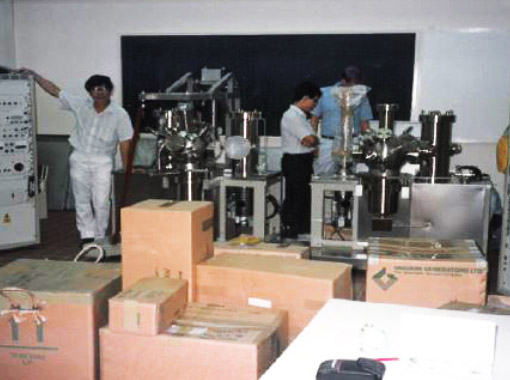
Figure 1a. Delivery and installation of the VG ESCALAB Mk 2/SIMSLAB at the NUS Surface Science Laboratory; Prof Tan Kuang Lee is standing on the left.
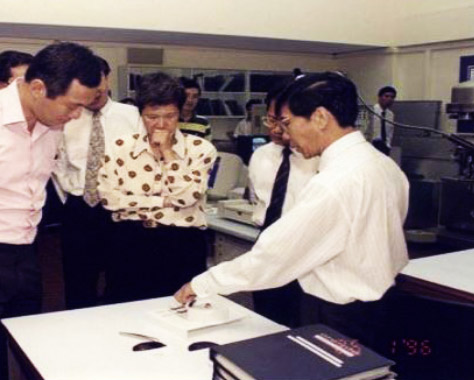
Figure 1b. Prof Tan hosting a 1996 visit of PM (then DPM) Mr Lee Hsien Loong.
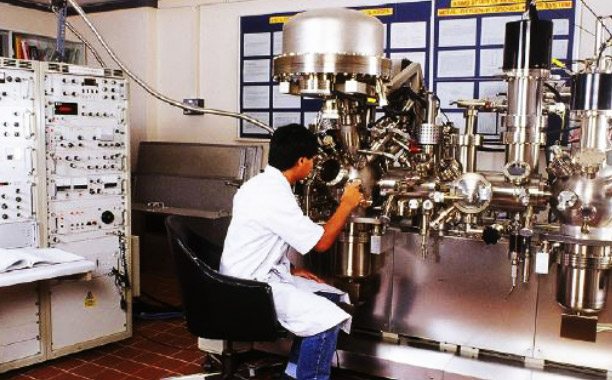
Prof Andrew Wee joined NUS in 1990 and succeeded as lab director after Prof Tan Kuang Lee retired. He and other surface science colleagues helped to grow the Surface Science Laboratory from a single UHV system to several state-of-art UHV systems today. As one of the earliest major research laboratories in NUS, the Surface Science Laboratory is recognized today as one of the world’s leading surface science groups producing numerous international journal publications and patents, and participating in numerous international collaborations. The lab also actively engages local industry, and has organised surface and interface analysis workshops to raise Singapore companies’ competency in stateof-the-art materials characterization techniques.
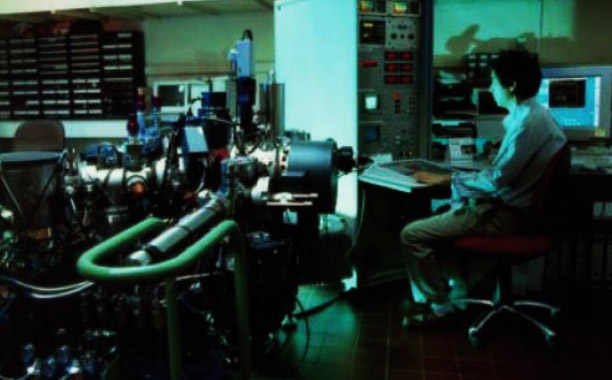
The laboratory currently houses five ultrahigh vacuum (UHV) systems (as of mid-2015), including the ESCALAB, Omicron low-temperature scanning tunneling microscope (LT-STM), Omicron variable-temperature (VT)-STM, ultraviolet/x-ray photoelectron spectroscopy (UPS/XPS) system, and Cameca IMS 6f Secondary Ion Mass Spectrometry (SIMS) system, along with an array of thin film growth systems, and other characterization equipment (Figures 2a,b). In 2000, we received a S$3M NSTB grant to set up the Surface-Interface-Nanostructure-Science (SINS) beamline and endstation (Figure 3) at the Singapore Synchrotron Light Source (SSLS)4. The synchrotron source produces highly monochromatic and tunable x-rays which serve as a unique probe to study surfaces and interfaces.

Figure 3. The Surface-Interface-Nanostructure-Science (SINS) beamline.

God made the bulk;
surfaces were invented by the devil.
Indeed, surfaces are critically important in modern technology, such as in the fields of heterogeneous catalysis, optical and electronic devices, protective coatings, adhesion, sensors, energy storage and generation and so on. We expect an exciting future for the Surface Science Laboratory in the years to come.

Figure 4a. Low temperature scanning tunnelling microscope (STM) with growth chamber attached.

Figure 4b. STM image of epitaxial graphene with model schematic superposed (Nature News 25 March 2009; Nature 458, 390-391 (2009)).
Box Story 3
Centre for Superconducting and Magnetic Materials
By: Ong Chong Kim
The Centre for Superconducting and Magnetic Materials (CSMM) at the Department of Physics was established in May 1998. Professor Ong Chong Kim was the founding and current director. The centre is internationally known for its research in superconductive physics and devices. Other fields of research include materials science, optics, ferroelectrics, and ferromagnetics.
In February 1999, soon after its founding, CSMM played a key role as one of the four founding centres in the inception of the Institute of Engineering Science(IES). IES is a university-level research institute for talented researchers who desire to focus on longer term high profile and high quality multi-disciplinary research.
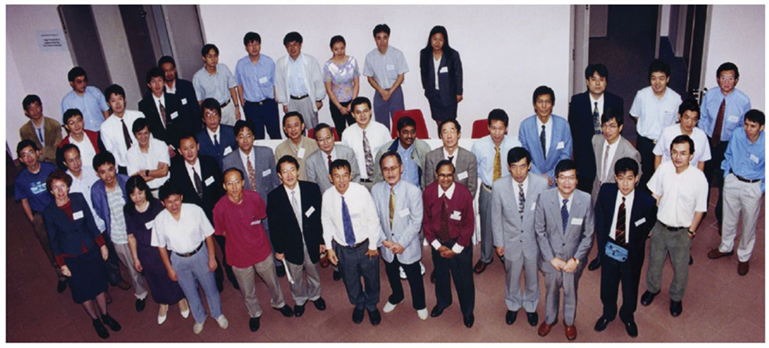
Fig. 1 The inaugural East Asia Symposium on Superconductive Electronics held in Dec 1999 in Singapore
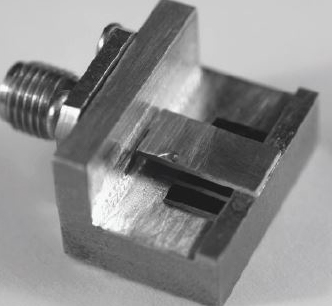
The past, present and future areas of research at CSMM include:
- Developing functional metamaterials for microwave electronics, especially high Tc superconducting, magnetic and ferroelectric nanostructures.
- Using thin films to make miniature high performance devices;
- Exploring new design ideas and innovative applications;
- Developing “proof of concept” products and prototypes;
- Designing and building sophisticated materials fabrication and characterization facilities in-house to advance research and
- Researching fundamental materials science.
Since its inception, the CSMM has been actively involved in organising conferences in NUS for materials researchers and industry to share their latest findings, exploring directions for research and collaboration, and to transfer new findings to industries. The inaugural workshop organised by CSMM was held in Singapore on December 1999 under the title “JSPS-NUS workshop on Superconducting Thin Film and Devices”. The workshop later evolved into the East Asia Symposium on Superconductive Electronics series which is currently organised once every two years rotating among Singapore, Japan, Korea, Taiwan and India. Fig. 1 shows a photo of the participants at the inaugural conference in 1999.
As the economic and technological importance of magnetism and electromagnetic materials grew in Singapore, CSMM took the lead by organising symposiums on magnetism and superconductivity under ICMAT in Singapore, China and India. CSMM helped to organise a workshop on High Temperature (Tc) Superconducting Materials and Applications was organized in Hanoi in 2004. CSMM is also a key contributor to the “International Conference on space charge physics in Dielectric” organised by the French Vacuum Society and the IEEE-DEIS technical committee.
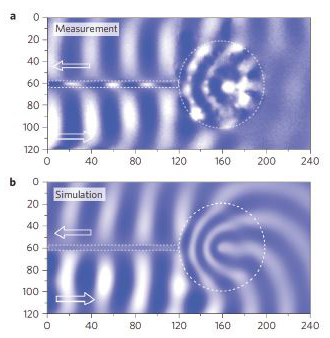
Starting in September 1999, CSMM and the Data Storage Institute began hosting an annual workshop on magnetic materials and devices, which has provided the forum for academics, members of research institutes and industrial researchers to meet.
The CSMM occupies a floor area of 220m² at the Department of Physics and consists of well-equipped research laboratories that have been staffed by generations of talented and committed researchers. CSMM has been well funded by the Defence Science Organization (DSO), and other government agencies and has made important contributions in the study of materials physics and the development of hybrid multi-layer thin film devices. Most of the state-of-the-art facilities are designed and constructed in-house.
One of CSMM’s strengths has been its ability to integrate materials research and in its preparation and characterisation of film and nanostructures. Its approach in the measurement of permittivity and permeability has been well received in the scientific community. Fig. 2 shows the shorted microstrip fixture used to characterise dynamic properties of magnetic thin film. It can measure up to 12 GHz at elevated temperatures of up to 150oC. An external magnetic field can be applied at any angle to the samples through Helmholtz coils. The device has now become an international standard for characterising the dynamic properties of ferromagnetic thin film. The fixture later extended into the sensitive detection and quantification of Spin Rectification Effect (SRE). It is useful for spin current measurement and spin wave characterisation.
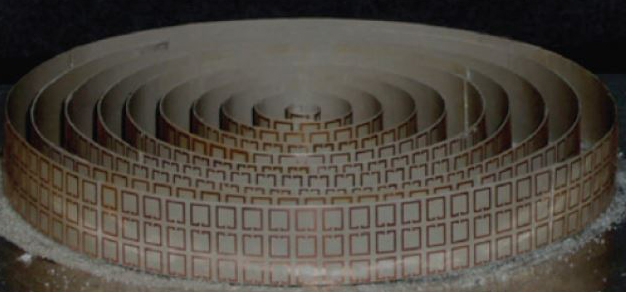
CSMM is also highly regarded in the scientific community for its capabilities in device design and implementation. It uses two parallel approaches to improve the performance of devices by studying the underlying science of the materials and by improving the device design through technology development and theoretical simulation.
CSMM is constantly breaking new ground in R&D. The core of its success lies in a conducive research atmosphere, in-house design expertise, close collaboration with research institutions in Singapore such as Temasek Labs, DSO, IMRE, and DSI and the ability to serve the R&D needs of the industry. This has yielded excellent results. For example, CSMM demonstrated that crystalline yttrium-stabilised zirconium oxide as a high k dielectric can be used as an alternative to SiO2 in MOS devices. This solution was recommended by the industry journal, Semiconductor International in May 2001 and it resulted in high k dielectrics being adopted for use in commercial products in the semiconductor industry. (Fig. 3)
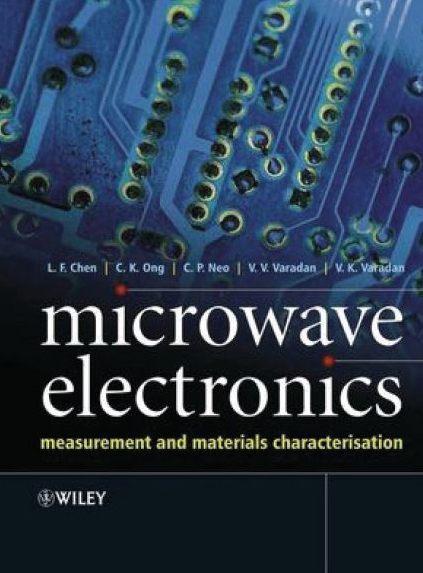
One of CSMM’s achievements in the field of metamaterials was the fabrication and implementation of an omnidirectional retroreflector, a device once deemed impossible to construct that can reflect microwaves perfectly back to their source from all angles. This has opened up a world of practical applications, especially for radar tracking.
The paper was published in Nature Materials (volume 8, pg 639-642, 2009) entitled “An Omnidirectional Retroreflector based on the Transmutation of Dielectric Singularities”. The authors were Ma Y.G., Ong C.K., Tye T and Leohardt U. The paper was introduced and described by Dennis M.R. of the University of Bristol in the same issue of Nature Materials as, “A Cat’s Eye for all Directions”. (Fig. 4)
The paper was also reported by a particular Saturday (July 4, 2009, page 8) issue of the Straits Times. It was also promoted by Discovery Channel News, on MSNBC’s web site http://www.msnbc.msn.com/id/31968012/ns/technology_and_science-innovat
In 2004, experts from CSMM wrote a 680-page textbook on microwave measurement entitled “Microwave Electronics: Measurement and Materials Characterisation” published by John Wiley and Sons Ltd, 680 pages. (Fig. 5) This book provides an in-depth coverage of both established and emerging techniques in materials characterisation based on microwave electronics. It represented the most comprehensive treatment of the topics up to that time. The materials characterised ranged from dielectrics, semiconductors, conductors, magnetic materials to artificial materials, while the electromagnetic properties characterised included permittivity, permeability, chirality, mobility and surface impedance.
CSMM received a US patent in 2005 for the “Electrically Tunable Microwave Devices with Patterned Ferroelectric Thin Film”. This invention enabled the fabrication of patterned ferroelectric thin film without degrading either the substrate or conductive circuit layers, thereby improving the performance of the microwave devices. The device also has the advantage of being readily incorporated into most current fabrication processes for ferroelectric thin film. This invention has wide applications in modern devices such as phase shifters (used in phased array antenna for radar tracking systems, multi-point communication systems and satellite broadcasting), tunable filter (for cellular base stations and relay satellites), and tunable matching network (for amplifiers, filters and balances).
To date, 33 PhD, 34 MSc and 57 final year BSc students have completed their theses based on their research at CSMM. As a recognition of his career achievements and his work at CSMM, Prof Ong Chong Kim received the NUS Outstanding Researcher Award in 2010.
Box Story 4
Development of the Centre for Quantum Technologies
By: Oh Choo Hiap and Lai Choy Heng
In tandem with NUS progressing into a world class research university, the Department of Physics firmed up a research road map in the year 2000.
The purpose of the roadmap was to identify, select and develop key areas and objectives as the short- and long- term research goals in the department. As with all good plans the roadmap must be reviewed and modified regularly to suit changing needs and goals in Singapore and in the physics world. Five broad yet closely related areas were selected, incorporating existing research and proposing new areas:
- Physics of Nanostructures,
- Condensed Matter and Materials Physics,
- Quantum Computation and Information,
- Nonlinear Dynamics and Complex Systems,
- Biophysics.
The Quantum Computation and Information and Biophysics areas were new. These new directions turned out to be fruitful. One was the basis of the research centre of excellence, the Centre for Quantum Technologies (CQT), and the other formed part of the effort in the formation of another research centre of excellence, the Mechanobiology Institute.
The Centre for Quantum Technologies plays a key role in positioning Singapore to become one of the leading nations in the world in the cutting edge quantum technology.
This important centre had its origin in research in quantum information science by a team led by Lai Choy Heng and Oh Choo Hiap in 1998. With the support of NUS and then NSTB/A*STAR, the team grew in strength to become the Quantum Information Technology (QIT) Group at the department level. With the effort and help from Lai Choy Heng (then Dean of Science Faculty), Chow Shui Nee (Director of Research), and Lim Khiang Wee (NSTB, ASTAR), a proposal for the Temasek Professorship (TP) as approved by Lee Tong Heng (Director of Research) was submitted to NSTB in August 2001. The TP was awarded with a grant amount $500,000 for the period of 3 years (2002 to 2005) by NSTB and Artur Ekert (Oxford University, UK) was appointed as the TP on 1 February 2002. It came with the TP Project in Quantum Information Technology (QIT) and a grant amount $4,999,750 for 3 years with Oh Choo Hiap as the Project Manager. A state-of-art experimental research laboratory in quantum information technology was established, the photo below was at the initial stage of the lab.
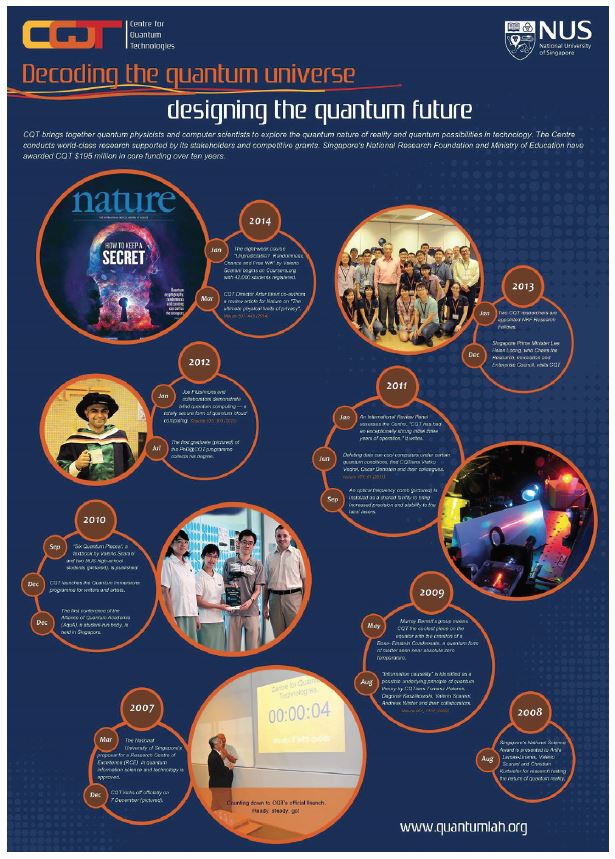
A poster highlighting CQT development
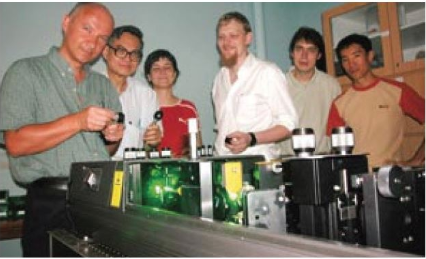
Experiments studying the generation of entangled photons and free space quantum cryptography were accomplished. The QIT Lab attracted many visitors. The photo below was taken during the visit by the Nobel Laureate Professor Tony Leggett in April 2005.
With the A*STAR appointment of Artur Ekert (Oxford University, UK) as the Temasek Professor, the existing local expertise, and newly appointed researchers as NUS faculty members, the Quantum Information Technology group at NUS quickly became internationally recognised as one of the most dynamic and promising groups in the field. The group gained world recognition for its work on several breakthrough results published in top physics journals. It has established extensive collaborations around the world, including the University of Cambridge and Oxford in UK, the Moscow State University, the National Institute of Standards and Technology (USA), the University of Science and Technology (China) and Tsing Hua University (China).
The popular science magazine New Scientist in 2004 featured the team’s research and cited the story as one of the 10 top science stories of the year.
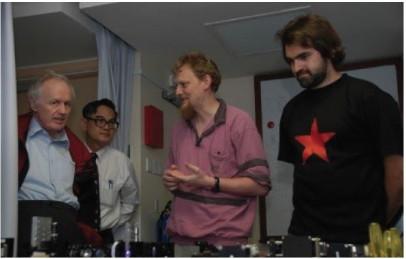
In 2006, the team comprising Oh Choo Hiap, Berge Englert, Dagomir Kaszlikowski and Kwek Leong Chuan (NIE/NTU), received the National Science Award for their outstanding contributions to theoretical research on quantum coherence and its applications. Their work have a great potential to lead to a significant boost in further experimental and industrial exploitation of coherent quantum phenomena (secure communication included) in Singapore.
In 2007, the NUS proposal for Research Centre of Excellence (RCE) in quantum information science and technology was approved and the Centre for Quantum Technologies (CQT) was established officially on 7 December 2007. The Singapore’s National Research Foundation (NRF) and Ministry of Education (MOE) had awarded CQT $195 million in core funding over ten years. The aim is to develop a worldclass research program focused on understanding, controlling and exploring potential applications of quantum phenomena. Research activities span both theory and experiment. CQT has since brought together quantum physicists and computer scientists to explore the quantum nature of reality and quantum possibilities in technology.
Box Story 5
Graphene Research Centre & Centre for Advanced 2D Materials
By: Feng Yuan Ping
Graphene related research in Department of Physics, NUS, began before graphene became a hot research topic. In 2000, Chen Ping et. al. published a paper in Carbon, in which graphene was extensively referenced. Following the successful fabrication of single layer carbon by mechanical exfoliation by Andre Geim and Konstantin Novoselov in 2004, more researchers in the department started working on this amazing two-dimensional (2D) material. Research groups such as Chen Wei, Andrew Wee, Feng Yuan Ping, etc. joined the gold rush and started publishing their results from 2007. In the late 2007, the Department of Physics recruited Barbaros Özyilmaz, a leading young experimentalist in graphene research, through the National Research Foundation (NRF) Research Fellowship scheme. At the same time, NRF awarded one of six projects in its pioneering Competitive Research Programmes (CRP) to a team led by Loh Kian Ping of the Department of Chemistry to conduct research on graphene. Physics faculty members Andrew Wee, Feng Yuan Ping, and R. Mahendiran are among the co-principal-investigators of the project. With Barbaros joining the department and significant funding from NRF, graphene research in the department as well as in NUS gained momentum. In November 2008, the Asian Conference on Nanoscience and Nanotechnology (AsiaNANO) was held in Singapore, and a symposium on graphene was organized by Barbaros Özyilmaz and Loh Kian Ping. Many of the leading researchers in the young field of graphene research gathered in Biopolis, Singapore. They reported their latest results and shared their views on graphene research. Subsequently, a number of international workshops and conferences on graphene were organised in Singapore, which attracted world attention of Singapore’s effort in graphene research.
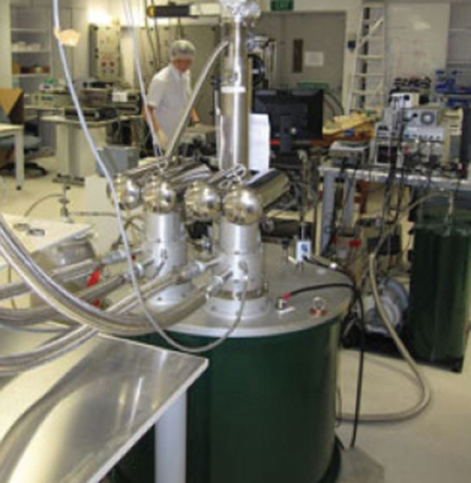
Inside the Centre for Advanced 2D Materials
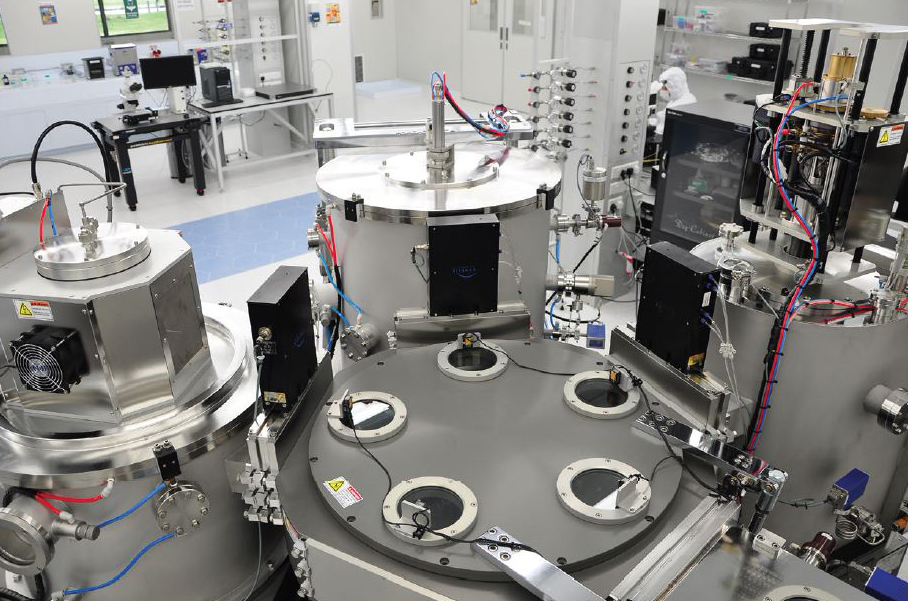
In 2010, NUS invested more than $40 million to set up a Graphene Research Centre (GRC), the first in Asia. Antonio Castro-Neto joined the department and became the Director of GRC. The centre was hosted in the Faculty of Science and operated through the Department of Physics. A number of new physicists were recruited, including NRF research fellows Goki Eda (2011), Shaffique Adam (2012), Slaven Garaj (2012), Quek Su Ying (2013), Lin Hsin (2013). In addition, Vitor Pereira and Jens Martin joined the department in 2010 and 2012, respectively. They conduct their research in the GRC and became core members of the centre. This further strengthened NUS’ leadership as a world centre for graphene research. Over the years, PIs of GRC have attracted significant additional research funding. Nobel Laureate Andre Geim has been a visiting professor at the centre and the department. Both Andre Geim and Konstantin Novoselov serve in GRC’s Scientific Advisory panel. NUS is ranked among the top institutions for graphene research in terms of research output.
By 2014, research activities in the centre have expanded to other 2D materials such as 2D transition metal dichalcogenides. To better reflect the research activities, the GRC was renamed the Centre for Advanced 2D Materials (CA2DM) and upgraded to a university level research centre in 2014. NRF provided additional funding of $50 million to support research activities and commercialization of research results. As of December 2015, CA2DM consisted of 4 major research groups, Graphene, Other 2D Materials, Devices, and Theory, led by Barbaros Ozyilmaz, Loh Kian Ping, Lim Chwee Teck and Feng Yuan Ping, respectively. 55 PIs from various departments of NUS as well as other local universities and research institutes, including 10 NRF research fellows, are conducting cutting edge research on 2D materials. Physics faculty members, Antonio Castro-Neto, Barbaros Ozyilmaz, Andrew Wee, Quek Su Ying, Hsin Lin, Shaffique Adam, Slaven Garaj, Chen Wei, Feng Yuan Ping, Ji Wei, Chua Lay-Lay, Peter Ho, Sow Chorng Haur, Utkur Misaidov and Zhang Chun are among the core members. In addition, an Industrial Liaison Office was set up in CA2DM, led by Tricia Chong, to facilitate industrial collaboration and commercialisation of research results. 2D materials has become a major focus area in NUS, and CA2DM is recognised as a leading centre for 2D materials research in the world.

